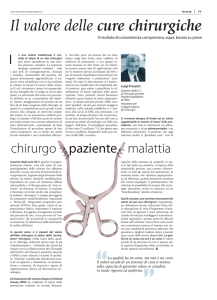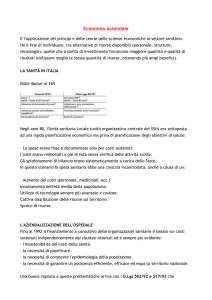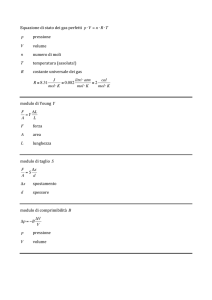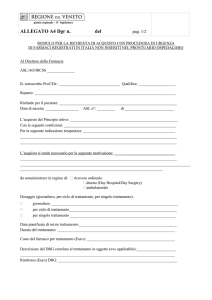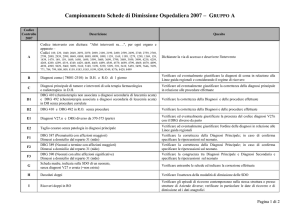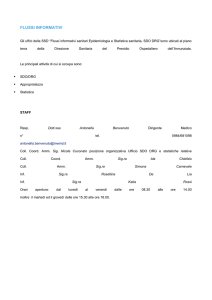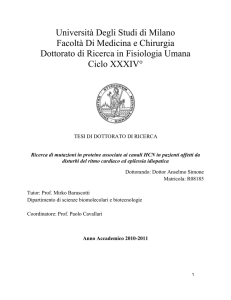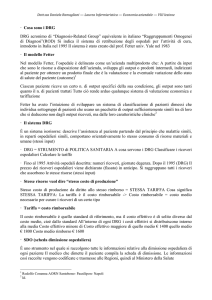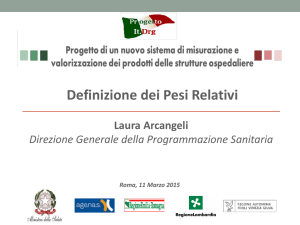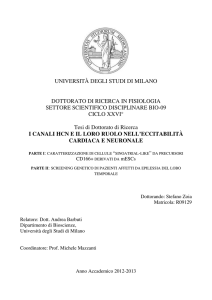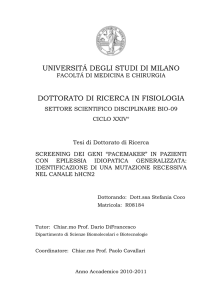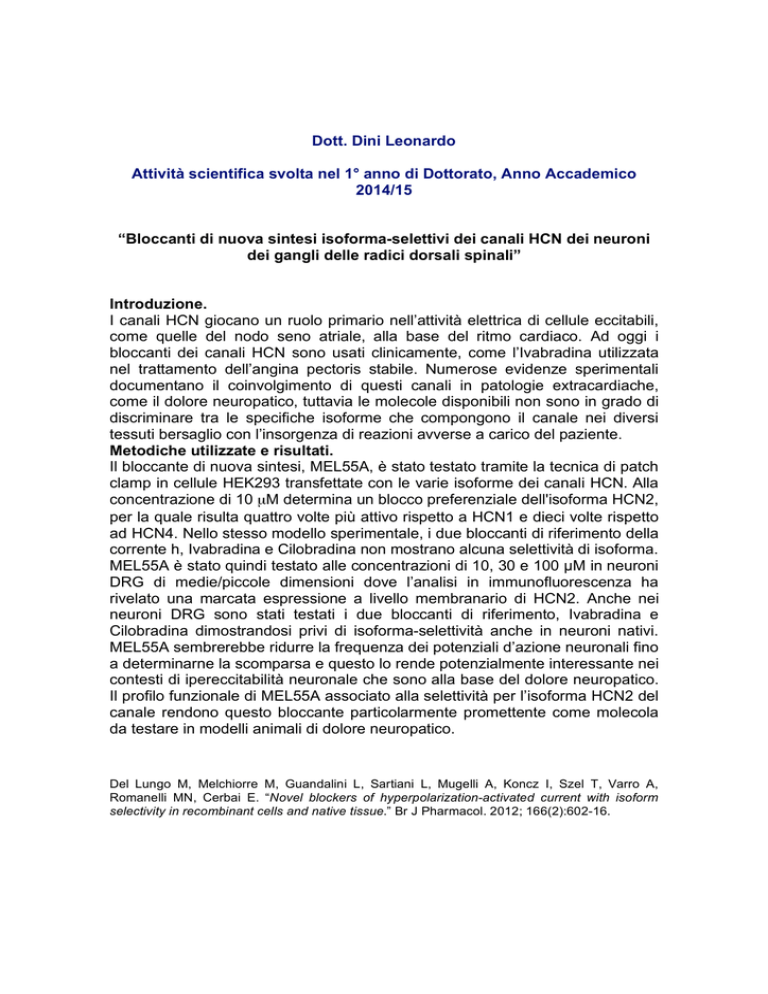
Dott. Dini Leonardo
Attività scientifica svolta nel 1° anno di Dottorato, Anno Accademico
2014/15
“Bloccanti di nuova sintesi isoforma-selettivi dei canali HCN dei neuroni
dei gangli delle radici dorsali spinali”
Introduzione.
I canali HCN giocano un ruolo primario nell’attività elettrica di cellule eccitabili,
come quelle del nodo seno atriale, alla base del ritmo cardiaco. Ad oggi i
bloccanti dei canali HCN sono usati clinicamente, come l’Ivabradina utilizzata
nel trattamento dell’angina pectoris stabile. Numerose evidenze sperimentali
documentano il coinvolgimento di questi canali in patologie extracardiache,
come il dolore neuropatico, tuttavia le molecole disponibili non sono in grado di
discriminare tra le specifiche isoforme che compongono il canale nei diversi
tessuti bersaglio con l’insorgenza di reazioni avverse a carico del paziente.
Metodiche utilizzate e risultati.
Il bloccante di nuova sintesi, MEL55A, è stato testato tramite la tecnica di patch
clamp in cellule HEK293 transfettate con le varie isoforme dei canali HCN. Alla
concentrazione di 10 µM determina un blocco preferenziale dell'isoforma HCN2,
per la quale risulta quattro volte più attivo rispetto a HCN1 e dieci volte rispetto
ad HCN4. Nello stesso modello sperimentale, i due bloccanti di riferimento della
corrente h, Ivabradina e Cilobradina non mostrano alcuna selettività di isoforma.
MEL55A è stato quindi testato alle concentrazioni di 10, 30 e 100 µM in neuroni
DRG di medie/piccole dimensioni dove l’analisi in immunofluorescenza ha
rivelato una marcata espressione a livello membranario di HCN2. Anche nei
neuroni DRG sono stati testati i due bloccanti di riferimento, Ivabradina e
Cilobradina dimostrandosi privi di isoforma-selettività anche in neuroni nativi.
MEL55A sembrerebbe ridurre la frequenza dei potenziali d’azione neuronali fino
a determinarne la scomparsa e questo lo rende potenzialmente interessante nei
contesti di ipereccitabilità neuronale che sono alla base del dolore neuropatico.
Il profilo funzionale di MEL55A associato alla selettività per l’isoforma HCN2 del
canale rendono questo bloccante particolarmente promettente come molecola
da testare in modelli animali di dolore neuropatico.
Del Lungo M, Melchiorre M, Guandalini L, Sartiani L, Mugelli A, Koncz I, Szel T, Varro A,
Romanelli MN, Cerbai E. “Novel blockers of hyperpolarization-activated current with isoform
selectivity in recombinant cells and native tissue.” Br J Pharmacol. 2012; 166(2):602-16.
• Partecipazione al 37° Congresso Nazionale della Società Italiana di
Farmacologia (SIF). Sessione poster “Ion channels and transport mechanisms”.
Napoli 27-30 Ottobre 2015.
MEL55A is a novel blocker of hyperpolarization-activated (HCN) channels
with isoform selectivity and therapeutic potential in the pain axis
L. Dini1, M. Del Lungo1, F. Resta1, MN Romanelli1, L. Sartiani1, A. Mugelli1, E.
Cerbai1.
1
Department of Neuroscience, Psychology, Drug Research and Child Health (NEUROFARBA), University
of Florence, Viale G. Pieraccini 6, 50139 Florence, Italy.
HCN channels have a primary role in the regulation of intrinsic excitability and
rythmogenesis of cardiac sinoatrial node cells, central and peripheral neurons.
Ivabradine (Procoralan or Corlentor) is the only HCN channel blocker on the
market, approved as bradycardic agent in the treatment of stable angina and
cardiac failure.
Emerging evidence document the involvement of HCN channels in extracardiac pathologies, including neuropathic pain, thus greatly enhancing the
therapeutic potential of HCN blockers. Currently, the different molecules
available for clinical use do not discriminate the different isoforms
(HCN1/2/3/4), which form tissue-specific channel types, thus severely limiting
the possibility to target selectively HCN channels in a distinct tissue and
prevent the occurrence of adverse reactions.
We have recently identified new phenylalkylamine derivatives able to block
HCN channels with potency comparable to that of reference compounds
cilobradine and ivabradine, and showing isoform selectivity. Among them,
preliminary experiments indicated that MEL55A (1) is more selective toward
HCN2 isoform, leading to consider it as potential candidate as HCN current
blocker in dorsal root ganglia (DRG) neurons, expressing mainly HCN2, which
play an essential role in transmitting signals in the spinal cord (2).
The aim of this study was to characterize the isoform selectivity of MEL55A in
recombinant HCN channel system and its electrophysiological properties in
native HCN current expressed in DGR neurons.
Isoform selectivity was assessed by single-cell patch-clamp recordings in
HEK293 cells re-expressing mHCN1, mHCN2 and hHCN4 channels. Effect on
native current was studied in DRG neurons cultured for at least 24h from
dissociation from mouse spinal cord. In the same cells action potential
recordings were performed in the current clamp mode. Immunofluorescence
microscopy was used to characterize the expression pattern and the
localization of HCN channels in DRG neurons.
Electrophysiological recordings of recombinant HCN channel showed that
MEL55A (10µmol/L) is able to cause a preferential block of HCN2 isoform,
which at -80mV was reduced by 71% (0.17±0.07 vs 0.05±0.01 pS/pF, n=4-3).
At the same concentration HCN1 was blocked by 66% (0.72±0.05 vs
0.24±0.07 pS/pF, n=4) and HCN4 by 33% (0.4±0.07 vs 0.27 ±0.07 pS/pF,
n=4). In the same conditions, ivabradine (10µmol/L) confirmed the lack of
isoform-selectivity, being HCN1 blocked by 51% (0.82±0.06 vs 0.4±0.08
pS/pF, n=5), HCN2 by 19% (0.21±0.04 vs 0.17 ±0.1 pS/pF, n=6); and HCN4
by 51% (0.42±0.07 vs 0.20 ±0.06 pS/pF, n=5). In DRG neurons MEL55A
(10µmol/L) reduced current by 71% (0.26±0.06 vs. 0.08±0.05 pS/pF, n=7-4).
Analysis of activation curve revealed that degree of current blockade was
more pronounced at less negative potential (-80mV), a property that confirms
the preferential block of HCN2, which contributes more to the current in DRG
neurons. In the same cells, immunofluorescence staining revealed a strong
expression of HCN2 at the membrane level that is associated with a less
pronounced expression of HCN1. Finally, preliminary experiments in DRG
neurons showed that MEL55A is able to increase the threshold of excitability,
delay the latency and prolong the duration of action potential. Further
investigations are necessary to establish the functional consequences of
these effects on overall DRG neurons excitability.
Taken together these data encourage the use of MEL55A in animal model of
neuropatic pain, where pain axis is regulated by DRG function and/or
dysfunction; they also could pave the way for novel drug design of potential
benefit in pain. The general conclusion is that the selectivity of HCN blockers
is an affordable approach to target preferentially HCN function in a distinct
tissue.
1. Melchiorre M, et al. J. Med. Chem.,2010, 53 (18), 6773-6777.
2. Momin A, et al. J Physiol. 2008; 15;586(Pt 24):5911-29.

